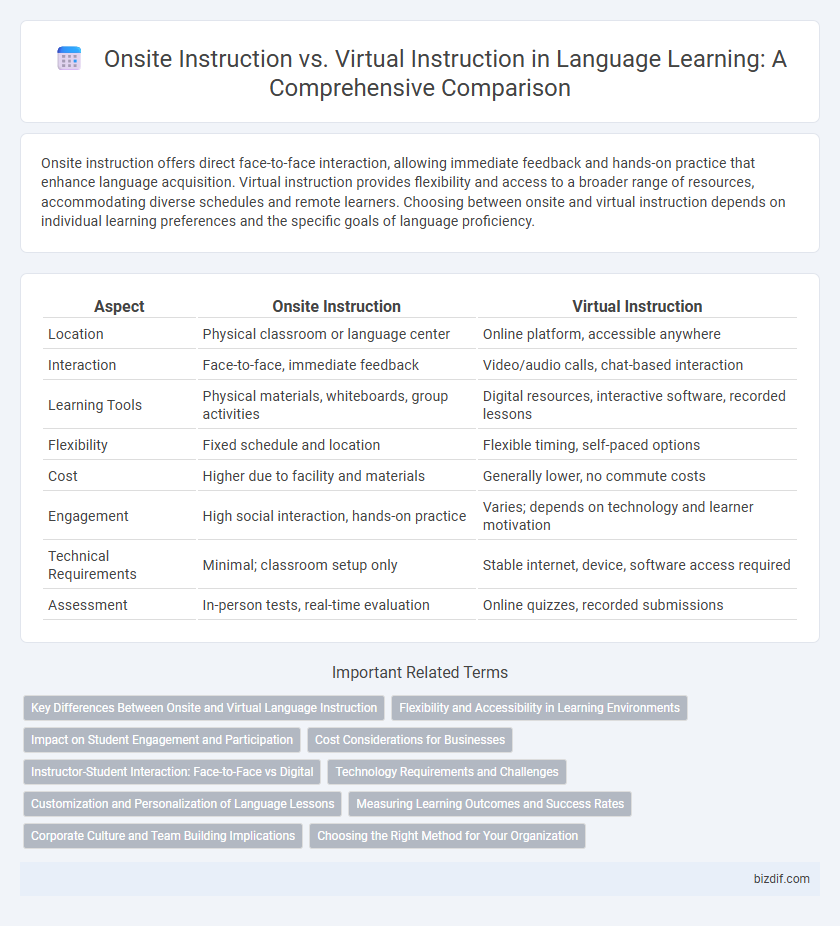Onsite instruction offers direct face-to-face interaction, allowing immediate feedback and hands-on practice that enhance language acquisition. Virtual instruction provides flexibility and access to a broader range of resources, accommodating diverse schedules and remote learners. Choosing between onsite and virtual instruction depends on individual learning preferences and the specific goals of language proficiency.
Table of Comparison
| Aspect | Onsite Instruction | Virtual Instruction |
|---|---|---|
| Location | Physical classroom or language center | Online platform, accessible anywhere |
| Interaction | Face-to-face, immediate feedback | Video/audio calls, chat-based interaction |
| Learning Tools | Physical materials, whiteboards, group activities | Digital resources, interactive software, recorded lessons |
| Flexibility | Fixed schedule and location | Flexible timing, self-paced options |
| Cost | Higher due to facility and materials | Generally lower, no commute costs |
| Engagement | High social interaction, hands-on practice | Varies; depends on technology and learner motivation |
| Technical Requirements | Minimal; classroom setup only | Stable internet, device, software access required |
| Assessment | In-person tests, real-time evaluation | Online quizzes, recorded submissions |
Key Differences Between Onsite and Virtual Language Instruction
Onsite language instruction involves face-to-face interaction, providing immediate feedback and immersive cultural experiences, which enhance speaking and listening skills. Virtual language instruction offers flexibility and access to diverse resources through digital platforms, enabling personalized pacing but may limit spontaneous conversational practice. Key differences include the mode of communication, level of social engagement, and adaptability to students' schedules, impacting overall language acquisition effectiveness.
Flexibility and Accessibility in Learning Environments
Onsite instruction provides structured learning environments with direct interaction, fostering immediate feedback but often limits flexibility due to fixed schedules and locations. Virtual instruction offers enhanced accessibility and adaptable scheduling, allowing learners from diverse geographic areas to engage with content at their own pace. Combining both methods maximizes flexibility and accessibility, catering to varied learning preferences and creating inclusive educational experiences.
Impact on Student Engagement and Participation
Onsite instruction fosters higher student engagement through face-to-face interaction, immediate feedback, and hands-on activities, which enhance participation and learning retention. Virtual instruction offers flexible access but may struggle with reduced nonverbal cues and potential distractions, leading to varied participation levels. Incorporating interactive digital tools and structured schedules in virtual settings can mitigate engagement challenges and promote active involvement.
Cost Considerations for Businesses
Onsite instruction often incurs higher costs for businesses due to expenses related to physical space, utilities, and travel, while virtual instruction reduces overhead by eliminating these needs and enables scalable training options. Technology investments in platforms and reliable internet connectivity are central to virtual instruction expenses but typically remain lower than maintaining onsite facilities. Businesses should also evaluate productivity impacts and potential savings from reduced absenteeism when comparing the overall cost-effectiveness of onsite versus virtual language instruction.
Instructor-Student Interaction: Face-to-Face vs Digital
Onsite instruction fosters dynamic instructor-student interaction through direct eye contact, body language, and immediate feedback, enhancing engagement and personalized support. Virtual instruction relies on digital tools such as video conferencing platforms, chat functions, and interactive software to facilitate communication, though it may reduce nonverbal cues and spontaneous dialogue. Effective virtual environments often incorporate breakout rooms and real-time polling to simulate the interactivity of face-to-face learning.
Technology Requirements and Challenges
Onsite instruction requires minimal technology, typically limited to projectors, whiteboards, and basic computer access, reducing reliance on high-speed internet and complex software. Virtual instruction demands robust technology infrastructure, including stable internet connections, compatible devices, and proficient use of learning management systems (LMS) and video conferencing tools, posing challenges such as technical glitches and digital literacy barriers. Both methods face unique challenges: onsite settings may struggle with integrating advanced tech tools smoothly, while virtual environments demand ongoing tech support and adaptation to rapidly evolving platforms.
Customization and Personalization of Language Lessons
Onsite language instruction enables tailored, face-to-face interactions that adapt instantly to learners' non-verbal cues and pronunciation nuances, fostering a highly personalized learning environment. Virtual instruction leverages adaptive technology and AI-driven platforms to customize lesson plans based on individual progress and learning preferences, offering flexible scheduling and access to diverse linguistic resources. Both methods prioritize customization but differ in delivery, with onsite providing immediate feedback and virtual instruction offering scalable, data-driven personalization.
Measuring Learning Outcomes and Success Rates
Measuring learning outcomes in onsite instruction often involves direct observation, hands-on assessments, and immediate feedback, which can lead to higher engagement and improved retention rates. Virtual instruction relies heavily on digital tools and analytics to track progress, with success rates varying based on technology access and student self-discipline. Studies show that hybrid models combining onsite and virtual elements tend to yield the most comprehensive success rates by balancing personalized interaction and flexible learning.
Corporate Culture and Team Building Implications
Onsite instruction fosters stronger corporate culture by enabling face-to-face interactions that enhance trust, communication, and collaboration among team members. Virtual instruction offers flexibility but may hinder spontaneous team bonding and subtle cultural cues essential for cohesive corporate identity. Investing in hybrid models can balance the benefits of both methods, supporting effective language learning while nurturing team dynamics and corporate values.
Choosing the Right Method for Your Organization
Onsite instruction offers direct interaction and hands-on learning, fostering immediate feedback and collaborative environments ideal for skill-based training. Virtual instruction provides flexibility, scalability, and access to a diverse range of digital resources, making it suitable for geographically dispersed teams or organizations with budget constraints. Assessing organizational goals, learner needs, and resource availability is crucial to determine the optimal language instruction method that enhances engagement and maximizes learning outcomes.
Onsite Instruction vs Virtual Instruction Infographic

 bizdif.com
bizdif.com